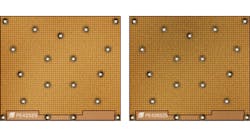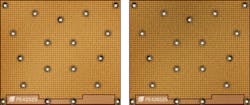This file type includes high-resolution graphics and schematics when applicable.
Fast switches are finding places in test instruments and communications equipment at higher and higher frequencies, with applications such as automotive safety systems and even backhaul links in Fifth-Generation (5G) wireless communications networks reaching millimeter-wave frequencies. To provide those switching functions, a pair of UltraCMOS silicon-on-insulator (SOI) single-pole, double-throw (SPDT) flip-chip switch die from Peregrine Semiconductor offer electrical performance from 9 kHz to 60 GHz with 8-ns switching speed.
The switches, models PE42525 and PE426525, are similar in physical configuration and performance. The one exception is that the PE426525 is designed to operate over an extended temperature range for use in hostile environments, including oilfields and in military applications.
The two reflective millimeter-wave switches (see figure) provide the low loss and high port-to-port isolation desirable in any broadband switch, especially for a bandwidth approaching 60 GHz. For both switches, the insertion loss is typically 0.9 dB at 100 MHz,
1.3 dB from 100 MHz to 26.5 GHz, 1.7 dB from 26.5 to 45.0 GHz, 1.9 dB from 45 to 50 GHz, and 2.6 dB from 50 to 60 GHz. Typical isolation is 76 dB at 100 MHz, 44 dB from 100 MHz to 26.5 GHz, 39 dB from 26.5 to 45.0 GHz, 38 dB from 45 to 50 GHz, and 38 dB from 50 to 60 GHz. Typical return loss is 20 dB at 100 MHz, 18 dB from 100 MHz to 26.5 GHz, 22 dB from 26.5 to 45.0 GHz, 20 dB from 45 to 50 GHz, and 12 dB from 50 to 60 GHz.
Die size is usually 2495 × 2149 µm. The SPDT switches are fabricated on silicon wafers that are customarily 200 µm thick. In addition, the flip-chip switch die are fabricated with a tight 500-µm bump pitch to minimize performance variations resulting from different bond wire lengths. Short interconnections also contribute to excellent time-domain performance, with typical switching speed of 8 ns and rise/fall time of 4 ns. The settling time is generally 40 ns from 50% of the control signal to within 0.05 dB of the final switched signal.
Power-Friendly
The switches provide linear operation at moderate power levels. The PE42525 has typical recommended high-level marks of +26 dBm at 100 MHz and +27 dBm at 26.5 GHz for continuous-wave (CW) signals, and +28 dBm at 100 MHz and +29 dBm at 26.5 GHz for pulsed signals. The PE426525 has typical recommended high-level marks of +24 dBm at 100 MHz and +25 dBm at 26.5 GHz for CW signals and +26 dBm at 100 MHz and +27 dBm at 26.5 GHz for pulsed signals. They are rated for maximum signal levels of +30 dBm at 100 MHz and +31 dBm at 26.5 GHz.
The switches achieve a typical 1-dB compression point (P1dB) of +33 dBm at 40 GHz and a third-order intercept point (IIP3) of +48 dBm at 13.5 GHz. Second-harmonic rejection is typically –74 dBc for an input frequency of 1.0 GHz and –78 dBc for an input frequency of 1.9 GHz.
These miniature millimeter-wave switches provide healthy electrostatic-discharge (ESD) protection of 2 kV, per the human body model (HBM). They operate with typical control current of 450 nA, a high control voltage of +3.0 V dc, and a low control voltage of –3.0 V dc. Model PE42525 is designed for operating temperatures from –40 to +105°C and model PE426525 for the wider range of operating temperatures from –55 to +125°C. P&A: $40 for the PE42525 and $48 for the PE426525 (1,000 qty.)
Peregrine Semiconductor Corp., 9380 Carroll Park Dr., San Diego, CA 92121; (858)731-9400, www.psemi.com.



